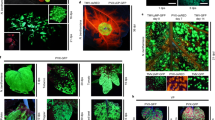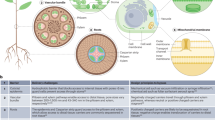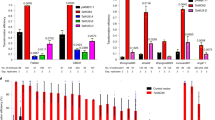Abstract
The efficiency of direct gene transfer to plant protoplasts has been increased more than 1000 fold over that previously reported. On the order of 2 percent of all colonies recovered without selection were transformed. The improvement was due to: treatment of protoplasts with a high voltage electric pulse (electroporation), optimization of the polyethylene glycol (PEG) concentration, addition of PEG after the DNA and the application of a heat shock (5 minutes at 45°C). These factors are of equal importance in achieving high transformation efficiencies.
This is a preview of subscription content, access via your institution
Access options
Subscribe to this journal
Receive 12 print issues and online access
$209.00 per year
only $17.42 per issue
Buy this article
- Purchase on Springer Link
- Instant access to full article PDF
Prices may be subject to local taxes which are calculated during checkout
Similar content being viewed by others
References
Paszkowski, J., Shillito, R.D., Saul, M., Mandak, V., Hohn, T., Hohn, B. and Potrykus, I. 1984. Direct gene transfer to plants, EMBO J. 3: 2717–2722.
Hain, R., Stabel, P., Czernilofski, A.P., Steinbiss, H.H., Herrera-Estrella, L. and Schell, J. 1985. Uptake, integration, expression and genetic transmission of a selectable chimeric gene by plant protoplasts. Mol. Gen. Genet. 199: 161–168.
Potrykus, I., Paszkowski, J., Saul, M., Petruska, J. and Shillito, R.D. 1985. Molecular and general genetics of a hybrid foreign gene introduced into tobacco by direct gene transfer. Mol. Gen. Genet. 199: 169–177.
Zambryski, P., Herrera-Estrella, L., de Block, M., van Montague, M. and Schell, J. 1984. The use of the Ti plasmid of A. tumefaciens to study the transfer of foreign DNA in plant cells: New vectors and methods, p. 253. In: Genetic Engineering, Vol. 6. A. Holaender and J. Setlow (eds.), Plenum Press, New York.
De Framond, A.J., Barton, K.A. and Chilton, M.-D. 1983. Mini-Ti—a new vector strategy for plant genetic engineering. Biotechnology 1: 262–269.
Potrykus, I., Saul, M., Petruska, J., Paszkowski, J. and Shillito, R.D. 1985. Direct gene transfer to cells of a graminaceous monocot. Mol. Gen. Genet. 199: 183–188.
Lörz, H., Baker, B. and Schell, J. 1985. Gene transfer to cereal cells mediated by protoplast transformation. Mol. Gen. Genet. 199: 178–182.
Krens, F.A., Molendijk, L., Wullems, G.J. and Schilperoort, R.A. 1982. In vitro transformation of plant protoplasts with Ti-plasmid DNA. Nature 296: 72–74.
Caboche, M. and Deshayes, A. 1984. Utilisation de liposomes pour la transformation de protoplastes de mesophyll de tabac par plasmide recombinant de E. coli leur conferent la resistance à la kanamycine. C. R. Acad. Sci. (Paris) 299: 663–666.
Neumann, E., Schaeffer-Ridder, M., Wang, Y. and Hofschneider, P.H. 1982. Gene transfer into mouse lymphoma cells by electroporation in high electric fields. EMBO J. 1: 841–845.
Potter, H., Weir, L. and Leder, P. 1984. Enhancer-dependent expression of human k immunoglobulin genes introduced into mouse pre-B lymphocytes by electroporation. Proc. Natl. Acad. Sci. USA. 81: 7161–7165.
Shillito, R.D., Paszkowski, J. and Potrykus, I. 1983. Agarose plating and a bead-type culture technique enable and stimulate development of protoplast-derived colonies in a number of plant species. Plant Cell Rep. 2: 244–247.
Falkner, F.G., Neumann, E. and Zachau, H.G. 1984. Tissue specificity of the initiation of immunoglobulin k gene transcription. Hoppe-Seyler's Z. Physiol. Chem. 365: 1331–1343.
Maliga, P., Breznovitz, A. and Marton, L. 1973. Streptomycin resistant plants from callus cultures of tobacco. Nature New Biol. 244: 29–30.
Nagy, J.I. and Maliga, P. 1976. Callus induction and plant regeneration from mesophyll protoplasts of N. sylvestris. Z. Pflanzenphysiol. 78: 453–455.
Paszkowski, J. and Saul, M. 1985. Direct gene transfer to plants. In: Methods in Enzymology, 118 (in press). A. Weissbach and H. Weissbach, (Eds.), Academic Press, Orlando, FL.
Kao, K.N. and Michayluk, M.R. 1975. Nutritional requirements for growth of Vicia hajastana cells at very low population density in liquid medium. Planta 126: 105–110.
Linsmaier, E.M. and Skoog, F. 1965. Organic growth factor requirements of tobacco tissue cultures. Physiol. Plant. 18: 100–127.
Potrykus, I. and Shillito, R.D. 1985. Protoplasts: isolation, culture, plant regeneration. In: Methods in Enzymology, 118, (in press). A. Weissbach and H. Weissbach, (Eds.), Academic Press, Orlando, FL.
Author information
Authors and Affiliations
Rights and permissions
About this article
Cite this article
Shillito, R., Saul, M., Paszkowski, J. et al. High Efficiency Direct Gene Transfer to Plants. Nat Biotechnol 3, 1099–1103 (1985). https://doi.org/10.1038/nbt1285-1099
Received:
Accepted:
Issue Date:
DOI: https://doi.org/10.1038/nbt1285-1099



